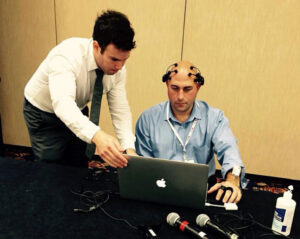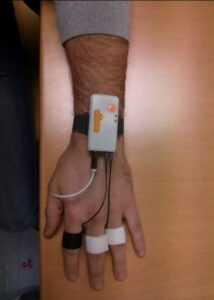Aren’t you all bored of strangers coming to you and asking to fill surveys and questionnaires, so that they can improve their product quality. Yeah, we flatly refuse to participate unless we’re paid for it.
UX researchers dream of understanding their users truly so that improvements can be done and better user experience can be offered, but is it really possible with the dull traditional methods of data collection?
These methods are highly subjective too. The answers depend on a lot of factors other than just the experience they had from the product. Sometimes they tell us what they think we wanna hear, or they might not be able to tell what they exactly feel; whether it’s good or bad feeling.
Thank god this lousy process is fainting every day, and we are moving to the next-Gen techniques that are helping us build some brilliant experiences for our users. The future of UX is not about asking boring questions and answers, but more about collecting data to analyse user’s thoughts, reactions, likings, dislikings and requirements to build a suitable product. Let’s see how modern techniques are reinventing the User Research.
Samsung is Watching You…
How many times you sleep off while catching a nice movie and then wake up not knowing exactly from where you missed it. But the intelligent Samsung Galaxy S4 pauses the movie when you are not looking at the screen. It was a smartphone wooed and welcomed by millions due to its super awesome eye-tracking feature.

This same technology has found a foothold in research. When we play an ad, or a motion image or a gif is being displayed; the research software can track whether the users are looking at it or not. It also helps in finding out how much time the user is spending on the specific ad/image, and where all they are focussing more. Researchers can then analyse what attracts users more and promotions and ads can be placed accordingly. Although it’s really helpful, it doesn’t give us a solution to find out ‘why’ the users are looking at the ad/image.
I Had a Head attack- EEG PLS!!
Electroencephalography (EEG) measures the brain activity like emotional responses etc. Electrodes are placed on different parts of the scalp and signals received are collected and represented as waveforms for analysis later. It is one of the most used, and more efficient forms of measuring the user emotions and feedbacks.
There are 3 main reasons why this can prove to be awesome for UX:
- Everything is recorded in real-time, so the data collected is very precise.
- A whole range of emotions is recorded, which is not possible with any other techniques.
- Every data collected, including the emotions, are received and recorded, are done instantly, without any delay. So chances of fraud are non-existent.

It’s a little difficult for the UX researchers to decode all the set of emotions in the waveform. But there are analytics tools to convert raw data into visualised emotional sets of happiness, sadness, engagement, interest and frustration.
Not just Your Face, Your Skin Expresses too
Main emotions like happiness and sadness can be found out through EEG. But what about the others, like boredom, stress, arousal and relaxation? We need some tool to analyse those too right. This is where Galvanic Skin Response (GSR) comes into the picture. In this technique, the GSR measures the electrical conductivity that happens due to a small amount of sweat generated by skin pores.
GSR measures the intensity of the emotion, like for how long the user is having a particular emotion, how long the engagement can be sustained etc. While using this technology, it’s always better to get a baseline measurement, because the sweat level of the user might vary according to the intensity of the situation. For example, they’ll be anxious as they are going to take a test, so having a baseline measurement will help in having a comparison.

The devices developed are not only comfortable for the users, but are also easy for the researchers to gather and use data. The only drawback of this technique is that it can detect the intensity of the emotion, but cannot interpret if it’s positive or negative. If you are riding a roller coaster, GSR will be able to tell you the intensity of excitement, but won’t be able to confirm whether you felt good or bad.
Face Expresses a Lot More Than Words
When we’re screwed, we are generally caught by our parents or friends, and they just reply ‘your face says it all’. :’D
Well, what else is better to find out emotions of a user than their facial expressions. Out of all the other techniques, this one is less intrusive too and captures emotions in a very automated manner.

It works similarly, as how any other face detectors in our mobiles or laptops work, detects the face and extract key features – like eyes, lips etc. It discovers whether the user is looking directly at the camera or not, analysing the intensity of the focus. Even though facial expressions are easy to collect and analyse, they are the least accurate of all.
Where are we getting with this?
Borrowing and implementing neuroscience and human psychology in UX research, can remove all limitations of the current techniques and improve the accuracy of analysing how user emotions impact UX.
There are a lot of techniques available, but it’s always better to use a combination of them, rather than using them individually. Because each of them has different advantages.
If eye tracking determines what attracts the user, what sustains them and the pattern of eye movements like where they are focusing more etc., EEG and GSR are fantastic for analysing and recording each and every minute variations during the whole experience like what makes them excited and engaged and which elements of that particular design generate the maximum interest.
The new age Biometric and Neurometric devices are practical and reasonably priced and are able to give more accurate results than plain old Q&As. These techniques are yet to gain popularity among researchers, but for sure they are the future of UX research.
Image Source 1 | Image Source 2 | Image Source 3| Image Source 4 |
